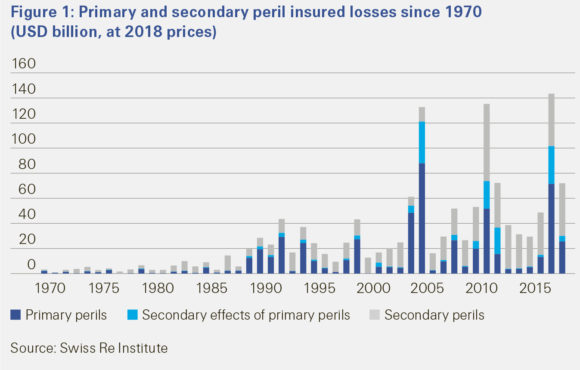

It’s only April, and already the United States has experienced two climate disasters that each caused $1 billion in damages and together killed five people, the National Oceanic and Atmospheric Administration reported this week.
NOAA’s National Centers for Environmental Information said a severe storm event that struck the Southeast, the Ohio Valley and the Northeast in February and historic Midwest flooding that began in March and is still ongoing each caused more than $1 billion in losses.
That may sound like a calamity, but compared to recent years, the first quarter of 2019 was tranquil.
NOAA reported three climate disasters that caused $4.8 billion in damages and 31 deaths in the first three months of 2018, six disasters with $10.9 billion in damages and 37 deaths in the first three months of 2017 and four disasters with $7.1 billion in damages and 16 deaths in the first three months of 2016.
On average, the United States experienced 6.3 billion-dollar loss events each year since NOAA started tracking the data in 1980. But in the past five years, the nation has experienced an average of 12.6 events each year, meaning climate-related disasters are much more frequent in recent years.
The number of $1 billion events isn’t boosted because of inflation. NOAA said the numbers are adjusted according to the Consumer Price Index and past events are added to the index when losses surpass the $1 billion mark.
The current year may appear relatively quiet because 2018 was an especially active year for weather disasters. NOAA said 14 events caused an estimated $91 billion in damages last year. That was the fourth highest number of events and the fourth-most costly in damages since 1980.
Last year’s weather-related disasters included wildfires in California and the West that killed 106 people and caused $24.2 billion in damages, Hurricane Michael which killed 49 and caused $25.2 billon in damages, and Hurricane Florence, which killed 53 and caused $24.2 billion in damages.
And 2017 was even worse, NOAA said. There were a 16 weather-related disasters in 2017, the most since NOAA started collecting data. Estimated damages topped $300 billion, also a record.

The insurance industry is keenly aware of the growing frequency and cost of climate-related disasters. Swiss Re Institute, an affiliate of the Zurich-based reinsurer, issued a report on Wednesday that said “secondary perils” are responsible for a growing share of natural catastrophe losses globally.
Swiss Re said the dangers of primary perils such as cyclones, earthquakes and winter storms in Europe, are well known and well monitored. But less severe “secondary perils,” such as river flooding, landslides, and wildfires, are not always included in models in proportion to their severity potential.
As it happens, the single largest insurance loss-event of 2018 was a secondary peril, the Camp Fire in Northern California. The blaze destroyed 18,500 buildings, killed 86 and caused $12 billion in damages.
Swiss Re said it expects losses from secondary perils to continue to grow.
“Secondary peril-losses will accelerate due to ongoing urbanization, also in areas exposed to flooding such as along coast lines and in river plains, development in areas vulnerable to fire risk like wildland-urban interface, and also because of long-term climate change projections,” said Edouard Schmid, Swiss Re Group’s chief underwriting officer, in a prepared statement.